-
What are the structural features of the eye?
- fibrous tunic, vascular tunic, nervous (sensory) tunic (retina), lens, anterior segment, and posterior segment
-
What is the eye in terms of shape alone?
3 layered sphere filled with fluid
-
What is the posterior segment of the eye?
posterior to lens
contains vitreous humor (gel-like)
-
What is the anterior segment of the eye?
anterior to lens
contains aqueous humor (fluid similar to plasma)
-
What are characteristics of the lens of the eye?
avascular, transparent
-
What is cataracts?
clouding of lens on the eye
-
What are the parts of the nervous (sensory) tunic, i.e. the retina?
- outer pigmented layer
- inner neural layer (3 layers of neurons)
- fovea centralis
- optic disc
-
What are the 3 layers of neurons in the inner neural layer of the retina?
- Photoreceptors (2 types): Rods (black and white) and Cones (colour)
- Bipolar Cells
- Ganglion Cells: axons from optic nerve (= Cranial Nerve II)
-
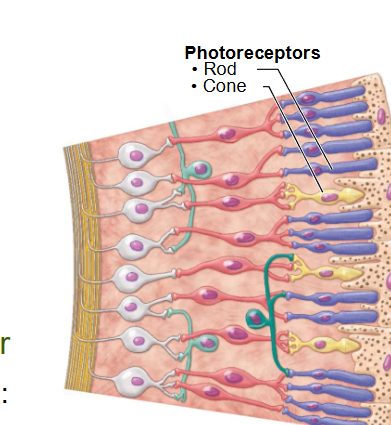
Name the 3 layers of neurons in the inner neural layer of the retina?
- Bipolar Cells (pink in pic)
- Ganglion Cells (white in pic)
-
What is the fovea centralis in the inner neural layer of the retina?
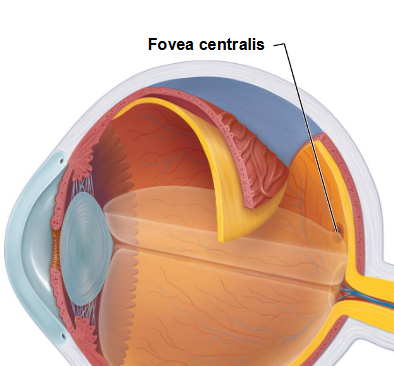
where light is focused
= area of greatest visual acuity
no rods, just cones
-
What is the optic disc in the inner neural layer of the retina?
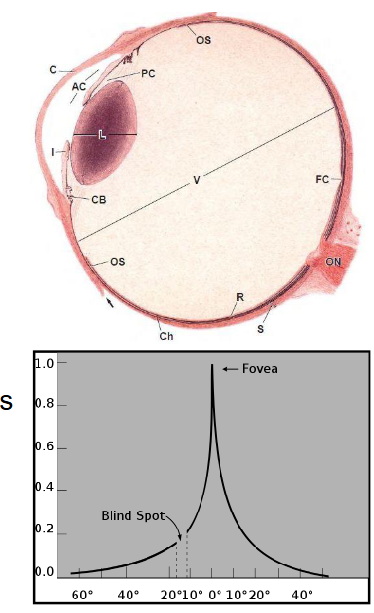
blind spot where blood vessels + optic nerve exit eye
no rods or cones
-
What are the parts of the fibrous tunic?
- sclera (white): avascular connective tissue (CT)
- cornea (transparent): avascular CT
- conjunctiva (covers anterior sclera, vascular mucous membrane, when vessels dilate = bloodshot eyes)
-
What are the structural features of the ear?
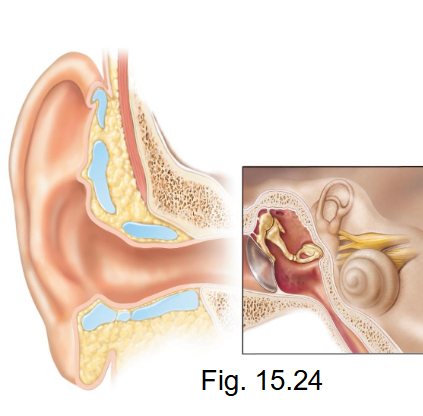
- external ear, middle ear, inner ear (labyrinth), cochlea, receptors in inner ear
-
What does the external ear do? What are the parts?
- conducts sound
- parts:
auricle (pinna, elastic cartilage, covered with skin)
external auditory canal (meatus)
tympanic membrane (eardrum)
-
What does the middle ear do? What are the parts?
- conducts sound
- parts: Eustachian tube (also called pharyngotympanic tube) and ear ossicles
-
What are the parts of ear ossicles in the middle ear?
- malleus (secured to tympanic membrane)
- incus
- stapes (transmits sound to inner ear via oval window)
-
What does the inner ear (labyrinth) do? What are the parts?
- conducts sound
- parts: bony labyrinth and membranous labyrinth
-
What is the bony labyrinth in the inner ear?
- tunnels in temporal bone (contain perilymph)
- parts:
- semicircular canals: equilibrium
- vestibule: equilibrium
- cochlea: hearing
-
What is the membranous labyrinth in the inner ear?
surrounded and protected by bony labyrinth
contains endolymph
-
What are the parts of the membranous labyrinth in the inner ear?
parts:
- semicircular duct (inside canals)
- utricle and saccule (inside vestibule)
- cochlear duct (inside cochlea)
-
What is the cochlea?
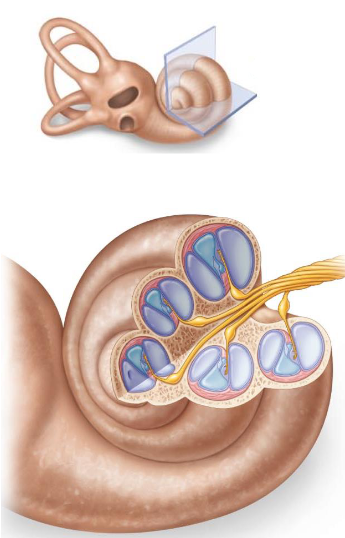
- coiled (and each coil has 3 channels)
- has 3 membranes
-
What are the 3 membranes of the cochlea?
- vestibular membrane: between cochlear duct + scala vestibuli
- basilar membrane: between cochlear duct + scala tympani
- tectorial membrane: covers hair cells (= receptor cells)
-
What are the 3 channels each coil of the cochlea has?
- scala vestibuli: upper; perilymph
- scala tympani: lower; perilymph
- cochlear duct: middle; endolymph
-
What are the receptors in the inner ear?
- called hair cells that synapse with neurons (send impulses to brain via cranial nerve VIII)
- hairs are cilia that extend into endolymph, the tips of cilia embedded in tectorial membrane (stability)

